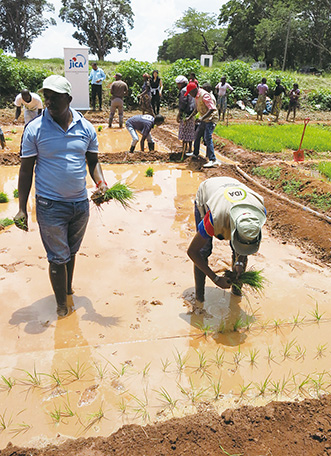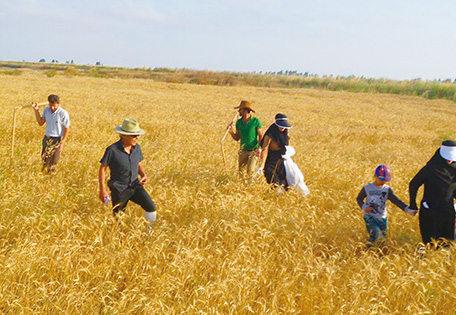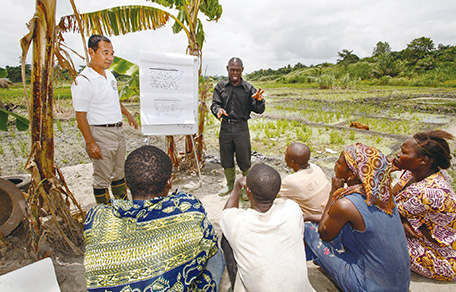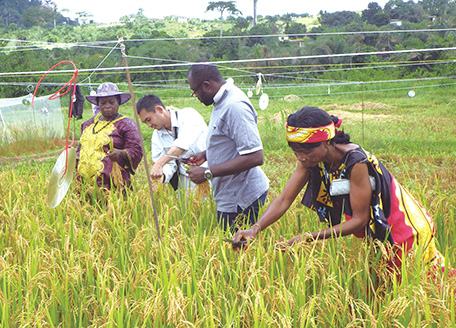Japan's Official Development Assistance White Paper 2013
(4) Agriculture
The population of undernourished people still remains large, and grain prices tend to rise again. In such circumstances, efforts towards agricultural development are urgent issue for the achievement of “eradication of extreme poverty and hunger,” Goal 1 of the MDGs. In addition, three out of four poor people in developing countries live in rural areas. Because the majority of these individuals rely on farming for living, efforts to develop agriculture and rural communities are important, and measures to reduce poverty and achieve sustainable development through economic growth are required.
<Japan’s Efforts>
As Japan’s ODA Charter states, Japan recognizes the importance of cooperation on agricultural efforts to poverty reduction and Japan is proactively striving to address food problems as a global issue. In the short term, Japan provides food assistance to avert food shortages, and in the medium- to long-term, Japan aims to help increase and improve production and productivity in developing countries in order to prevent and eliminate the cause of food shortages including hunger.
Specifically, Japan uses its knowledge and experience to strengthen development and disseminate capacity of agricultural production technology suited to the cultivation environment, to strengthen organizations of farmers, and to assist policy-making as well as to improve the infrastructures like irrigation facilities and farm roads. Japan has also supported the research of NERICA* (New Rice for Africa) and the spread of its production techniques, as well as introduction of a market-based agricultural promotion (SHEP: Smallholder Horticulture Empowerment Project) approach*. In particular, in order to assist for reducing post-harvest loss* and promoting intra-trade and distribution, Japan supports transportation/storage and improvement of loading ports at the distribution stage, as well as development and management of water resources and agricultural land resources. Through these efforts, Japan aims to build an efficient system of providing agricultural products and food, from production, processing, distribution to sales phase. Further, Japan provides assistance in the agricultural sector through the Food and Agriculture Organization of the UN (FAO), the International Fund for Agricultural Development (IFAD), the Consultative Group on International Agricultural Research (CGIAR), the World Food Programme (WFP), and other international organizations.

The first planting rice paddies in Angola (Photo: Naohiro Nosaka / JICA Angola Field Office)
At a side event of the TICAD IV in 2008, Japan announced the “Coalition for African Rice Development” (CARD)* initiative that aims at doubling African rice production in Sub-Saharan Africa from the original 14 million tons/year to 28 million tons/year over a period of ten years. Currently, Japan is working with rice-producing countries in Africa and international organizations, to support the creation of a National Rice Development Strategy (NRDS) for each of the 23 Sub-Saharan African countries, and is implementing projects based on that strategy.
In addition, at an outreach session on food security at G8 L’Aquila Summit (Italy) in July 2009, Japan pledged at least $3 billion over three years in 2010-2012 for agricultural development including infrastructure, and provided approximately $3.9 billion (commitment basis) by the end of 2012. Additionally, the rapid increase of agricultural investment in developing countries has become an international issue since it was reported as “land grab” by some media outlets. For this reason, Japan proposed Responsible Agricultural Investment (RAI)* at the L’Aquila Summit and has since been gaining support at international fora such as the G8, G20 and APEC. Furthermore, the G8 New Alliance for Food Security and Nutrition* was established at the G8 Camp David Summit (the U.S.) in May 2012. At an event held in relation to the G8 Lough Erne Summit (the United Kingdom) in June 2013, the progress report of the New Alliance was published and new African partner countries were announced. It was also announced that as a framework of the New Alliance, the relevant international organizations will implement the “Forward-looking research and analysis programme for responsible agricultural investment” with financial support from Japan. In September 2013, Japan held the Japan-African Regional Economic Communities (RECs) Summit Roundtable in New York, and discussed issues of agricultural development. Japan has stressed the importance of agriculture as an industry that will play an important role in ensuring food security, reducing poverty, and stimulating economic growth throughout Africa, and contributes to the development of agriculture in Africa.
Furthermore, Japan also promotes efforts to assist the Agricultural Market Information System (AMIS)*, which aims to enhance agricultural market transparency, in the G20.
At TICAD V in June 2013, Japan announced that as an assistance measure to promote market-based agriculture, it would provide assistance for human resource development of 1,000 technical advisers, develop organizations for 50,000 smallholder farmers, and dispatch experts, as well as promote the SHEP approach (to be rolled out in 10 countries.)

A Japanese expert and local extension officers collecting samples of wheat and barley from an agricultural field to survey the yield amount in Iran. (Photo: Kazuo Nakabayashi)
Glossary
- *NERICA
- NERICA (New Rice for Africa) is a general term for rice developed in 1994 by the Africa Rice Center (formerly West Africa Rice Development Association (WARDA)) through hybridization of high-yield Asian rice with African rice, which is strong against weeds, diseases and insect pests. Japan has also contributed to developing a variety of new types that are suited to the natural conditions of each region in Africa. The characteristics of the rice include (i) a higher yield, (ii) a shorter growth period, (iii) higher resistance to dryness (drought), and (iv) higher resistance to diseases and insect pests than conventional rice. Since 1997, Japan has partnered with international organizations and NGOs to provide support for research and development related to new types of NERICA, test cultivation, and increased production and popularization of seeds. In addition, Japan has dispatched agricultural experts and JOCV, and has accepted trainees from Africa for training in Japan.
- *Market-based agricultural promotion (SHEP*) approach for smallholder farmers
- An effort to assist smallholder farmers to enhance their agricultural organizations through trainings and research on local markets, and to provide guidance on cultivation techniques and development of agricultural roads while taking account of gender, in order to help them improve their capacities to manage their agricultural businesses in accordance with the market.
*SHEP: Smallholder Horticulture Empowerment Project - *Post-harvest loss
- Post-harvest loss refers to harvested food that is discarded, because it is unable to fulfill its originally intended purpose (for use as food, etc.). This can be caused by improper harvest timing, and overexposure to rain or dryness, extremely high or low temperatures, germ contamination, or any other physical damage that reduces the value of the products due to primarily lack of adequate storage facilities.
- *Coalition for African Rice Development (CARD)
- CARD is a consultative group composed of donor countries, African regional organizations, and international organizations partnered with rice-producing countries in Africa that are interested in rice development. The CARD Initiative was announced at TICAD IV in 2008. Japan plans to train 50,000 agricultural advisors in relation to doubling rice production.
- *Responsible Agricultural Investment (RAI)
- An initiative proposed by Japan at the G8 L’Aquila Summit in response to unintentional negative impacts that result from large-scale agricultural investment (acquisition of farmland with foreign capital) in developing countries. In addition to mitigating the negative impacts of agricultural investment, it aims to promote agricultural development in the host country as well as harmonize and maximize the benefits enjoyed by that country’s government, local people, and investors.
- *G8 New Alliance for Food Security and Nutrition
- With the cooperation of the G8, African countries, and the private sector, this initiative was launched under the aims of achieving sustainable and inclusive agricultural growth and lifting 50 million people in sub-Saharan Africa out of poverty over the next 10 years. Under the initiative, the Country Cooperation Framework was formulated for the African partner countries, which include financial commitment of the G8, specific policy actions by the governments of the partner countries, and private-sector investment intents. By June 2013, the cooperation framework was formulated for nine countries, including Ethiopia, Ghana, Côte d’Ivoire, Tanzania, Nigeria, Burkina Faso, Benin, Malawi, and Mozambique, and efforts are being promoted.
- *AMIS: Agricultural Market Information System
- Launched as a countermeasure against food price volatility by the G20 in 2011. It allows each of the G20 countries, the main exporting and importing countries, companies, and international organizations to share agricultural and food market information (production output, price, etc.) in a timely, precise, and transparent manner. Japan has supported the efforts of ASEAN countries through which they aim to improve the accuracy of ASEAN agricultural and statistical information used by AMIS as data.
●Ghana
Project for Sustainable Development of Rain-fed Lowland Rice Production in the Republic of Ghana
Technical Cooperation Project (July 2009 – Ongoing)
Rice, one of Ghana’s staple foods, has seen a rapid expansion in consumption levels in recent years. Due to stagnant levels of domestic rice production, however, Ghana relies on imported rice for about two-thirds of its domestic consumption requirements. In order to increase rice production in view of this situation, the Project for Sustainable Development of Rain-fed Lowland Rice Production in Ghana collaborates with local agriculture extension workers to spread techniques that improve productivity by leveraging Japan’s rice cultivation knowhow and techniques.
The beneficiary regions of this project are the lowland areas of the Ashanti Region, which has a high level of rice consumption, and the Northern Region, which has a thriving rice production industry. To mitigate the impacts of changes in rainfall levels on yield levels, the project teaches techniques that may be practiced even where irrigation facilities and farming machineries are unavailable, including the development of rice paddies that take into account methods of securing and using water as well as weeding using hand-operated equipment.
By disseminating techniques that small-scale farmers themselves can continue to implement, both yield level and rice quality have made steady improvements. Confirmed project outcomes have included a fourfold increase in the yield level from the previous 2.5 tons/ha. Increases in yield levels in turn have contributed to improvements in incomes and living standards.
It is expected that a manual will be created based on these achievements, and that rice cultivation methods that leverage Japanese techniques will be scaled up to other regions.
(As of August 2013)

Through the use of figures and photos, farmers learn techniques that can be practiced for increasing productivity (Photo: Akio Iizuka / JICA)
●Cameroon
Upland Rice Development of the Tropical Forest Zone in Cameroon
Technical Cooperation Project (July 2011 – Ongoing)
In Cameroon in the central region of Africa, the rice consumption level has been increasing yearly, especially in the metropolitan area. As the production level of domestic rice is small, however, Cameroon depends on imports for most of its demand. Since 2011, Japan has been implementing the “Upland Rice Development of the Tropical Forest Zone in Cameroon Project,” a Technical Cooperation Project that aims to disseminate upland rice cultivation techniques to about 10,000 farmers to expand rice production in the following three areas: the capital city of Yaoundé in the Central Region; Ebolowa in the South Region; and Batouri in the East Region.
In this project, motivated farmers are identified as core farmers. Through practices at pilot fields, guidance has been provided on cultivation methods and farming management. This project has taken a creative approach, i.e., when core farmers who have completed the training produce rice independently, extension workers make direct contact with the farmers by making use of the mobile phone network that has developed rapidly in Africa and thereby gauge the cultivation situation.
It is expected that core farmers who continue to cultivate rice and improve their livelihood will serve as precedent cases, and that this will motivate other farmers to increase production and spread upland rice cultivation.
(As of August 2013)

Training in seed harvesting and rice ear cutting (Photo: JICA)
